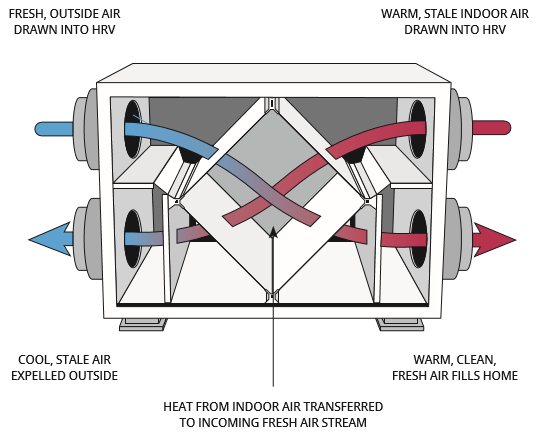Should You Buy HRV? Pros and Cons
The All-Inclusive Overview to the Uses of Heat Recovery Ventilation in Modern Structures
Heat Recovery Ventilation (HRV) systems stand for a considerable advancement in developing innovation (HRV Heat Recovery Ventilation). They offer a method for trading stagnant indoor air with fresh outside air while reducing power loss. This strategy not just improves indoor air high quality however additionally adds to energy performance in both residential and industrial structures. Comprehending the various applications and benefits of HRV can reveal its important role in contemporary layout and sustainability efforts. The ramifications of this modern technology are worth checking out further
Recognizing Heat Recovery Ventilation Systems

Although many modern-day structures focus on energy efficiency, understanding warm recovery air flow (HRV) systems is crucial for optimizing interior air top quality and lowering energy intake. HRV systems work by transferring warmth from stale interior air to inbound fresh air, efficiently keeping comfortable interior temperature levels while lessening power loss. These systems are composed of a heat exchanger, fans, and ductwork that assist in the flow of air. During winter season, HRV devices record and recycle warm from the outgoing air, while in summer, they can assist cool incoming air. By continually exchanging air, HRV systems also minimize moisture and the concentration of indoor toxins. Appropriate installment and maintenance of HRV systems are vital for their effectiveness and effectiveness in improving total structure efficiency and comfort.
Advantages of Heat Recovery Ventilation
Heat recovery ventilation systems provide many advantages that boost both power performance and indoor air high quality in modern-day buildings. By catching and recycling power from exhaust air, these systems significantly decrease cooling and heating prices, leading to reduced power intake. They maintain a constant circulation of fresh exterior air, decreasing the risk of interior air toxins and allergens. This constant exchange helps manage moisture degrees, stopping mold growth and ensuring a healthier living atmosphere. Furthermore, HRV systems add to sustainability objectives by decreasing general carbon footprints. Their capacity to maximize ventilation without compromising thermal comfort makes them a useful enhancement to modern building style, promoting both financial and ecological benefits.
Applications of HRV in Residential Buildings
As property owners significantly prioritize energy effectiveness and interior air high quality, the applications of warm recovery air flow (HRV) systems in domestic structures have actually come to be more prevalent. HRV systems are specifically helpful in firmly sealed homes, where maintaining fresh air blood circulation is essential for protecting against wetness build-up and indoor pollutants. They properly transfer warm from outward bound stagnant air to incoming fresh air, decreasing energy prices connected with heating & webpage cooling. Furthermore, HRVs can improve comfort degrees by managing moisture and temperature. They are also adaptable for different property designs, consisting of single-family homes and multi-unit structures. Overall, incorporating HRV systems supports lasting living methods while making certain a much healthier interior environment for owners.
HRV in Industrial and Commercial Settings
In industrial and industrial settings, the execution of warmth healing air flow (HRV) systems has become increasingly critical for optimizing power performance and keeping air quality. These systems efficiently move heat from exhaust air to incoming fresh air, lowering the need for extra heating or cooling. This not only lowers power prices but likewise adds to sustainability initiatives. Industries such as manufacturing, warehousing, and office complex profit greatly from HRV systems, as they aid control temperature and moisture levels, making sure a comfy and productive atmosphere. Furthermore, HRV systems help in eliminating pollutants and excess moisture, improving indoor air high quality. As guidelines around air top quality become stricter, the fostering of HRV innovation is likely to expand, making it a critical element of contemporary commercial and industrial facilities.
Future Patterns in Heat Recovery Ventilation Technology

Often Asked Concerns
How Does Heat Recovery Ventilation Influence Indoor Air Quality?
Heat recovery ventilation significantly improves indoor air quality by constantly trading stagnant interior air with fresh outdoor air while recovering power. This process decreases pollutants, keeps perfect humidity degrees, and ensures a much healthier atmosphere for residents.
Can HRV Solutions Be Installed in Existing Structures?
HRV systems can undoubtedly be set up in existing structures. Retrofitting might need modifications to ductwork and air flow formats, yet it significantly enhances power performance and interior air high quality, making it a viable option for older structures.
What Maintenance Is Required for HRV Systems?

Are There Details Climates Where HRV Is More Effective?
Heat recovery ventilation systems are specifically efficient in climates with substantial temperature distinctions between seasons. These systems optimize energy efficiency by recovering heat from exhaust air, making them suitable for both cold and reasonably warm environments.
Exactly How Do HRV Solutions Affect Power Expenses?
